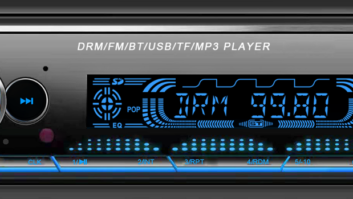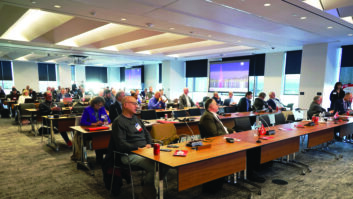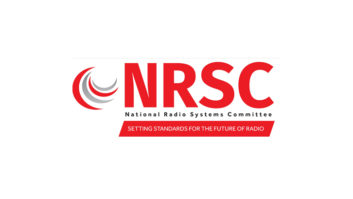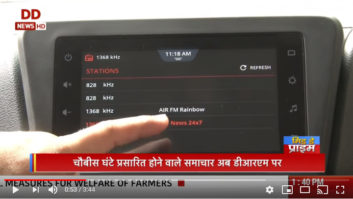The author is chairman of Digital Radio Mondiale. Her commentaries appear regularly in Radio World.
The recent DRM virtual showcase proved to be a real box of delights and new announcements demonstrating that the digital radio industry remains resilient and innovative even in pandemic times. “The best DRM IBC show with the lowest carbon footprint and best attendance” was one of the many feedbacks received. And there were lots of things to excite the over 100 participants from literally all over the world.
The highlights were grouped around some big themes like DRM in practice, extensively proven and used in the FM band; DRM and its possible major role in delivering educational content to large and remote areas in times when many students cannot attend face-to-face lessons; use of DRM in public signage which can be applied for both education, health and emergency announcements; a new and “live” way of monitoring on-air transmissions, which can be beneficial to both the engineers and the editorial staff of broadcasters.
[Read: Can Digital Radio Standards Coexist?]
While the all-band, open DRM standard is stable and well-established, technical improvements can always be implemented like the recent updating of the DRM system specification ETSI ES 201 980. Three improvements were announced by the DRM Technical Chair (BBC) and are to do with removal of some obsolete or unused modulation features and enhanced signaling when using emergency warnings. The changes, which are backwards-compatible, will make DRM’s implementation in chipsets and receivers more reliable, and add additional support for receiver text displays to be able to also support different scripts from around the world. We now know that the publication of the new ETSI version is expected early in 2021.
Around that time a DRM medium-wave pilot to be run by the BBC for the Middle East is also expected to start, as out of the 468 million people tuning to the BBC worldwide, we were told by the BBC representative that a quarter are still doing so on AM. And shortwave, a bit of a blast from the past for some, is not forgotten in places like Russia, China, and many other countries, as the demand for SW digital transmitters is quite healthy. As mentioned by the Ampegon representative the demand is mainly now for bigger capacity transmitters, above 25 kW going to 50 kW, able to cover wide areas with good analog and digital sound and delivering big energy savings. In its new factory Ampegon is working on satisfying these demands.
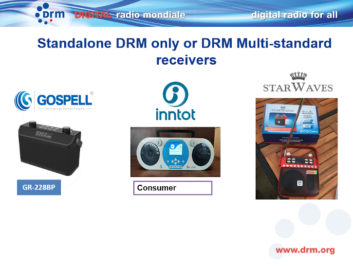 Improvements were also announced at the level of professional monitoring all these transmissions. So RFmondial announced the upgraded HTML5 GUI in its DRM/AM Monitoring and Measurement Receiver Family RF-SE and the possible software update of older versions. A new exciter version was also unveiled by the German company. Their German colleagues at Fraunhofer IIS also completed the picture with end-to-end implementations offering solutions (content server and multimedia player, data services like Journaline and Emergency Warning Functionality), services for supporting DRM field trials and rollout, as well as unique expertise.
Improvements were also announced at the level of professional monitoring all these transmissions. So RFmondial announced the upgraded HTML5 GUI in its DRM/AM Monitoring and Measurement Receiver Family RF-SE and the possible software update of older versions. A new exciter version was also unveiled by the German company. Their German colleagues at Fraunhofer IIS also completed the picture with end-to-end implementations offering solutions (content server and multimedia player, data services like Journaline and Emergency Warning Functionality), services for supporting DRM field trials and rollout, as well as unique expertise.
But the DRM Showcase was not all about better hardware. It was also about technical innovation. And the one that elicited most of the questions was the extended DRM multiplex for FM, an idea that benefited from the input of Nautel and RFmondial engineers. This solution allows one analog FM transmission (200 kHz) and four DRM channels (two in each of the 200 kHz guard spaces as a DRM channel only occupies 100 kHz). Or if the whole 600 kHz are used in pure DRM then up to six DRM channels (each service with up to three audio and one data services) can be offered from the same transmitter, same antenna with possible sharing of costs among several broadcasters. The individual broadcasters remain in control of their transmissions without the involvement of third-parties.
As usual, participants were also interested in what is happening in the various countries about implementing DRM. While India remains the top DRM country (alongside China), the adoption of DRM in all bands by Pakistan and its public broadcaster (PBC) was one of the big surprises of the showcase. The comprehensive three-phase costed plan to introduce DRM in FM, and medium-wave, first, in all the key areas of the country has been endorsed and praised by top Pakistani officials.
Indonesia and its public radio (RRI) representative also presented its five FM transmitters which went on air over the last few months and the excellent results of the Emergency Warning Functionality demonstrated on a DRM FM transmitter in Jakarta in August. The recent tender for digital DRM transmitters in SW, MW and FM in Brazil was welcome news and the expectation is now that a locally produced SW DRM transmitter will be soon transmitting from the key public broadcaster central site.
Africa always gets a mention though South Africa has really scored a first with its policy announced two months ago that it recommends both DRM and DAB as a way to digitize radio in the country; a true torch-bearer for other African countries so reliant on AM and FM radio.
Over 2.5 million of cars with DRM receivers are placing India in a class of its own. Receivers are fitted at no cost in cars from the top brands. Work is continuing to increase pure DRM hours for five All India Radio (AIR) transmitters to full day and diversify content. Possibilities are being explored to have an educational channel and invite also some private broadcasters to use the extra channels available through DRM on AIR transmitters. Six more medium-wave transmitters are to be added to the existing 35 MW DRM transmitters. One of these new batch of DRM transmitters using all the extra DRM features will be launched officially in Hyderabad very soon. The increase of the DRM presence and the general technical effort being made will stimulate the receiver production and availability.
And a good part of the DRM event was devoted to the development of receiver and receiver solutions. One trend we noticed was the extension of DRM reception to FM so that it can cover analog and AM as well as FM broadcasts. Most of the receiver manufacturers proudly announced the availability of attractive features like support for xHE-AAC codec, Journaline, Emergency Warnings. The receivers introduced in excellent videos like that of Avion (India) came in all shapes and forms; from the rich variety of Gospell (China) and its GR series and DRM car stereo, to the Indian multifunctional receivers and SDR-based solutions of Inntot (India). RF2 digital (Korea/Germany) also came up with an SDR receiver solution for analog and all DRM bands, being also a multistandard device. Cambridge Consultants (U.K.) is working on a very low-energy and low-cost solution. The same idea was embraced by Starwaves (Germany/Switzerland) which presented a “tuk-tuk” radio (stripped down but very functional). It also announced the world premiere of Starwaves W293BT receiver, available now upon orders.
So, DRM is making great strides technically, geographically and in coming up with ingenious receiver solutions. To encourage as many digital radio practitioners, stakeholders and decisionmakers to embrace and implement digital radio, DRM, the consortium launched on Sept. 9 its own new video, “DRM — From Broadcaster to Listener.”



